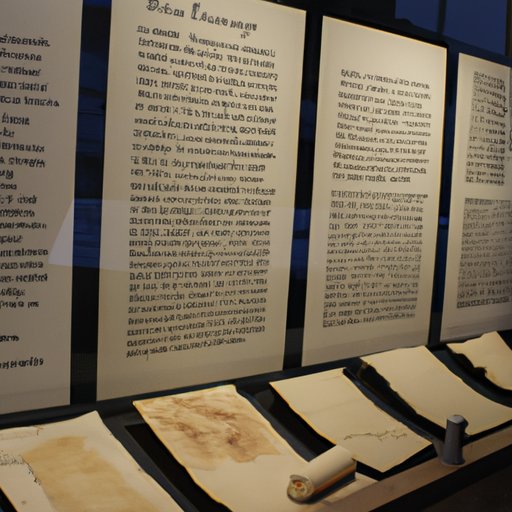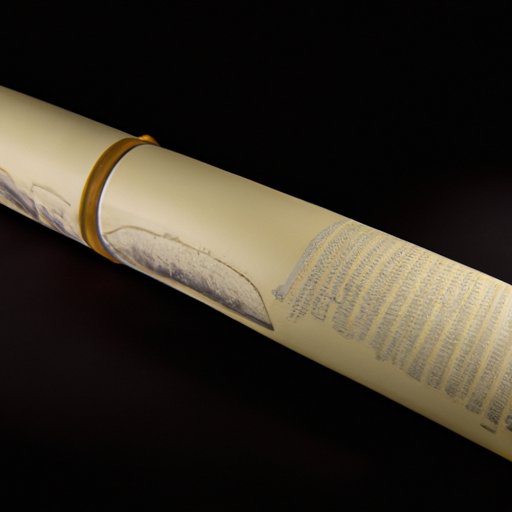Introduction
Paper is a thin material made from cellulose fibers derived from plants such as hemp, flax, cotton, and bamboo. It is used for writing, printing, packaging, and many other purposes. The history of paper dates back to ancient China, where it was invented by Cai Lun in 105 CE. Since then, paper has become an integral part of society, revolutionizing communication, record keeping, and access to information. In this article, we will explore why paper was invented, its impact on society, and its cultural significance throughout history.
Exploring the History of Paper and Its Invention
The origins of paper can be traced back to ancient China, where it was invented by Cai Lun in 105 CE. Prior to the invention of paper, people relied on materials such as papyrus, animal skins, and clay tablets for writing and record keeping. According to legend, Cai Lun was inspired by the use of tree bark and rags to create a writing surface. He experimented with different combinations of materials until he created a sheet of paper that could be used for writing.
In the centuries that followed, papermaking spread to other parts of the world, including Europe and the Middle East. Early uses of paper included wrapping and packing goods, as well as writing and printing books. By the 19th century, paper had become a staple of everyday life, thanks to advances in production technology.

Examining the Benefits of Paper and its Impact on Society
The invention of paper revolutionized communication and record keeping, making it easier to share information and store data. Here are some of the benefits of paper:
- Improved Communication: Paper allowed for quicker and more efficient communication, as messages could be written down, copied, and distributed. This enabled the spread of ideas, news, and knowledge at a much faster pace than before.
- More Efficient Record Keeping: Paper made it easier to keep records of events and transactions, which laid the foundation for modern accounting practices. It also allowed for the preservation of historical documents, such as treaties and agreements.
- Increased Access to Information: Thanks to paper, knowledge and information became more widely available. Books, newspapers, magazines, and other printed materials could be produced and distributed at a much lower cost than before, making them accessible to a larger audience.
Analyzing How Paper Changed the Way We Communicate
The invention of paper had a profound impact on how people communicated with each other. Here are some of the ways in which paper changed the way we communicate:
- Increase in Literacy Rates: The ability to easily produce and distribute printed materials allowed for an increase in literacy rates. People were able to learn to read and write more quickly and effectively, leading to an overall improvement in education.
- Expansion of the Written Word: Paper enabled the expansion of the written word, as people could now write longer and more complex works. This led to the emergence of new genres of literature, such as novels, essays, and poetry.
- Emergence of Newspapers, Magazines, and Books: Paper allowed for the mass production of books, newspapers, and magazines, which gave people access to a wide range of information and knowledge. This contributed to the development of new ideas and perspectives.

Investigating Different Types of Paper and Their Uses
Today, there are many different types of paper available, each with its own unique characteristics and uses. Here are some of the most common types of paper:
- Bond Paper: Bond paper is a durable type of paper commonly used for stationery, business cards, and other professional documents. It is made from a combination of wood pulp and recycled paper.
- Coated Paper: Coated paper is treated with a coating that gives it a glossy or matte finish. It is often used for brochures, magazines, and other printed materials.
- Textured Paper: Textured paper is made from natural fibers and has a rough, tactile surface. It is often used for invitations, greeting cards, and other special occasions.

Understanding the Cultural Significance of Paper Throughout History
Paper has played an important role in the history of humankind. Throughout the centuries, it has been used for religious texts, artwork, and political documents. Here are some examples of the cultural significance of paper:
- Religious Texts: Paper was instrumental in the spread of religion, as it allowed for the production and distribution of religious texts such as the Bible and the Koran.
- Artwork: Paper has long been used as a medium for art, from traditional paintings and sketches to modern photography and digital art.
- Political Documents: Paper has been used to record and preserve important political documents, such as the Declaration of Independence and the Constitution.
Conclusion
Paper has been around for centuries and played an important role in the history of humankind. This article explored why paper was invented, its impact on society, and its cultural significance throughout history. From improved communication and record keeping to increased access to information, paper has revolutionized the way we communicate and interact with each other. It has also been used for religious texts, artwork, and political documents, making it a powerful tool for preserving our culture and heritage.
(Note: Is this article not meeting your expectations? Do you have knowledge or insights to share? Unlock new opportunities and expand your reach by joining our authors team. Click Registration to join us and share your expertise with our readers.)
